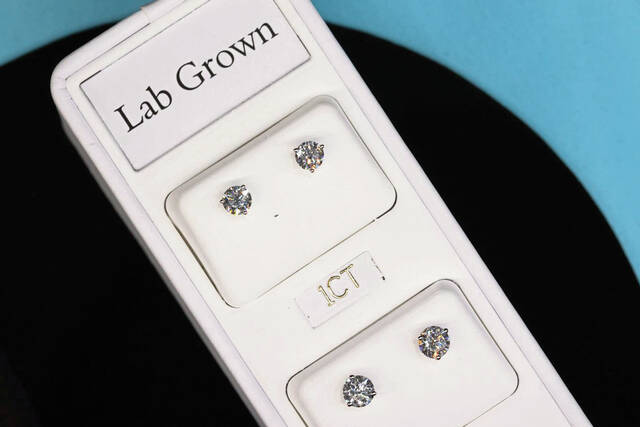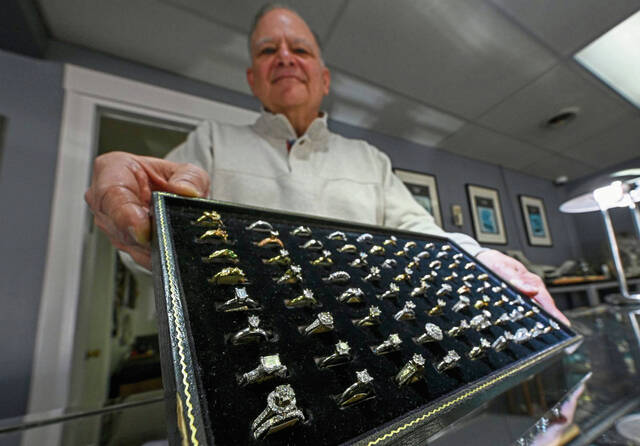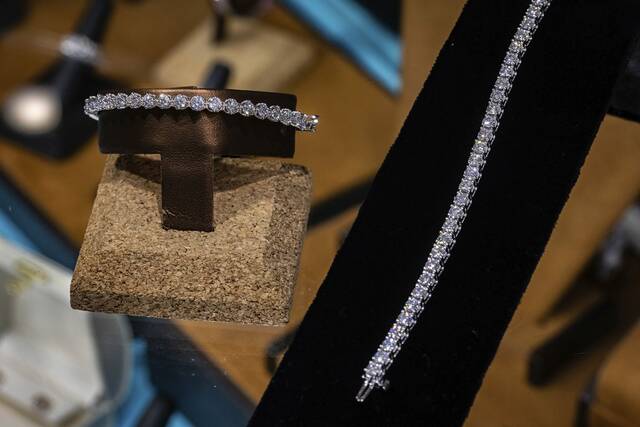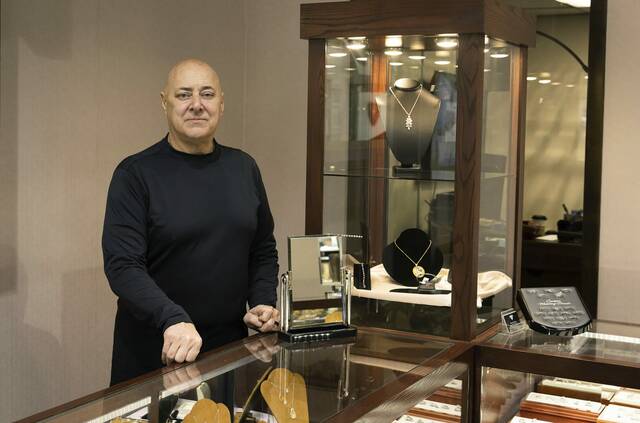Rock star: Lab-grown diamonds are skyrocketing in popularity, say local jewelers, industry experts
When Sandee Vargo lost one of her diamond earrings two years ago, she turned that sinking feeling into an opportunity to try something new.
Her remaining one-third carat stud earring was a natural diamond, mined from the ground. But Vargo of North Huntingdon became interested in another option for her replacement: lab-created diamonds. They’re physically identical to mined stones, sell for a fraction of the price and are considered by many consumers to be a more ethical and environmentally friendly choice over their traditional counterparts.
“The cost of having a matching real diamond and setting with the remaining earring was ridiculous,” she said. “I saw a beautiful pair of lab-created diamond studs, which were much less. I put my real diamond stud next to the lab-created. That was it.”
“The lab-created was more brilliant, and I purchased the set. If I lose one of these, it will be much less expensive to replace,” Vargo said.
She is among a growing number of consumers opting for lab-grown stones. According to co-owner Jeff DePalma of J & J Jewelers of Jeannette, about 80% of his customers now pass by the displays of naturally mined diamonds and make a beeline for the less-expensive lab-grown ones.
“Most people have their mind made up when they’re coming in, whether they want an earth or a lab diamond,” DePalma said. “I want to say, we’re selling probably seven or eight lab-grown to every three earth. … I think it’s here to stay.”
‘Come into the mainstream’
The technology to produce diamonds in a lab has advanced rapidly in recent years. First produced in the 1950s, lab-grown diamonds are now significantly cheaper and easier to make — and nearly indistinguishable from mined stones.
A torrent of lab-grown diamonds have flooded the market, lowering the price even more, and many customers have taken advantage of the opportunity.
“There’s been an exponential increase in interest in lab-grown diamonds. They’ve really come into the mainstream,” said Lisa Rosen, CEO of International Gem Society, an online gemology resource.
“(Originally,) the technology was extremely expensive to produce a lab grown diamond. As the tech has improved over time, the cost has come down dramatically. … They’re flooding the market and arguably turning the industry on its head,” Rosen said.
She even has one of her own.
“I have a 1½-carat lab-grown diamond ring,” Rosen said. “I wear it as I wear any other ring. … I don’t worry about it being brittle or breaking. I know it’s just as durable as a mined diamond.”
Lab-grown diamonds are real, genuine diamonds, she emphasized.
“It drives me insane when I hear people described them as artificial diamonds,” Rosen said. “Chemically, optically, physically, they are identical to a mined diamond.”
Spotting the difference
It can be difficult to tell the difference between a lab-grown and a mined diamond. Magnification can help, but it’s not always foolproof.
The differences are so minute it has led Dale Gordon of D.S. Gordon Jewelers in Lower Burrell to be more careful about what gems he buys for his store.
“Most lab-grown diamonds have a laser inscription on the edge of them — tiny, tiny printing that you can only see with 10- to 40-power magnification,” he said. “If somebody were to bring in a high-grade stone that I was interested in buying over the counter, I would have to look very closely to see if it were a natural diamond.”
Because the price of lab diamonds has fallen significantly in recent years, many jewelry stores are hesitant to buy them back for fear of losing money.
“If I see a stone that I’m not sure about and I do want to buy it over the counter, I just have to be suspicious of it and maybe not buy it at all,” Gordon said.
Brian Nicklaus, bench jeweler at Brian Nicklaus Jewelry inside the Pawn & Jewelry Exchange in Greensburg, says there are some clues that help jewelers identify lab diamonds.
“There’s subtle things that people who do this for a living, that I can tell right out of the gate, using context clues,” he said. “You won’t ever see off-quality lab diamonds. If somebody has a perfect diamond, (I’m) skeptical.”
Choosing lab or mined
Not only do consumers seek out lab diamonds for the lower price, some prefer them because they are concerned about the ethics of mined diamonds, which can come from war-torn regions or be produced under poor labor conditions.
But the manufacture of lab-grown diamonds has its own pitfalls. The process can use a lot of energy, and some companies are moving toward using renewable energy for their manufacture, Rosen said.
“Because there’s a huge supply of these lab-grown diamonds, the price has dropped dramatically,” she said. “If you have a budget, instead of buying a 1-carat mined diamond, you might be able to buy a 2½-carat or 3-carat lab diamond. It’s a pretty remarkable difference in price.”
That level of price difference is similar to what local jewelers have seen, noted Anna Daily at Greenfield Jewelers. She works with her father, Mike Daily, at the store and says 80% to 85% of the shop’s engagement ring sales are lab-grown. The diamonds’ popularity began to jump significantly in 2020, she said.
“Generally, (in my dad’s) generation, you got a quarter-carat or a half-carat for your wife. Nowadays, what you could spend on that, you can get a 1-carat or 2-carat diamond for that,” she said. “You get the beauty, you get the size, you get the style, you get the ring of your dreams for just a really reasonable price point.”
Some couples who choose a lab-grown diamond for an engagement ring do so because they want to use the money they save for something else, said Brian Beeghly, co-owner of Beeghly & Co. in Greensburg.
“Most of the time, we are looking at a couple and they are making this decision together,” he said. “They can say, ‘OK, we can take that $5,000 difference and put it on a wonderful honeymoon trip, against a house if we’re purchasing’ — or whatever else they’ve got going on in their life.”
Rosen noted neither lab nor mined diamonds should be considered an investment item.
“You shouldn’t buy a diamond engagement ring thinking that you are going to be able to sell it for more later,” she said. “It’s pretty much like buying a car. As soon as you take it out of a jewelry store, the diamond depreciates. … Mined diamonds don’t retain value very well either.”
Vargo also believes natural diamonds aren’t great for investment.
“Unless it is a legacy diamond or family heirloom, why start a marriage with additional debt for a huge, real diamond when you can get a lab-created one for far less money?” she said. “That big rock doesn’t really mean anything. You’re never going to get the value from it if you would need to sell it someday.”
Industry shake-up
Ty Wilson, who is one of the founders of online jewelry retailer CustomMade, also has witnessed the rise in popularity of lab-grown diamonds.
“We sold our first lab-grown diamonds in 2017 — two rings,” he said. “From there to this past year in 2023, 76% of our diamond sales were lab diamonds.”
The company has had to shift some of its goals to adjust for the differences in price, he said.
“The average price point is lower for a lab than a natural, but what we’re seeing is customers going for larger stones. They have more budget — so instead of for a natural diamond the average is about 1 carat, for a lab diamond the average is closer to 2 carats,” he said. “The average price is lower so we have to sell more units to make the same amount in terms of revenue.”
Wilson expects that smaller jewelers could find the shift toward lab-grown diamonds as a shock.
“Here, for generations, you’ve built a business mostly around natural diamonds, and it’s all shifting,” he said. “If you’re just selling on understanding of natural diamonds and how to get one at a great price, those jewelers are in a little bit of trouble.”
One part of the jewelry industry that is likely to be more impacted is that of clarity-enhanced diamonds, said Elisa Wilson, who works at Brian Nicklaus Jewelry. Natural diamonds that have inclusions or flaws in them can be treated through this process, but the widespread availability of lab diamonds has made this a less popular option.
“The fact that they can create a perfect diamond, are you going to spend $8,000 on a clarity-enhanced 2-carat or 3-carat round, or are you going to spend $3,000 on a lab-grown, perfect one?” she said. “A lot of the consumers are getting more educated.”
Trending ahead
In the future, Rosen said, jewelry tastes may change as lab-grown diamonds become even more affordable and within the reach of more consumers.
“A big diamond used to be a marker for wealth and status, and, now, everybody is going to be able to have a 3- or 4-carat diamond,” she said. “The idea that the big diamond ring is going to be a status symbol, I think that’s going to go away.”
She predicts more interest in natural-colored gemstones such as Paraiba tourmaline, padparadscha sapphires and Burmese red spinel.
“I think the really rare-colored gemstones are going to have a moment,” Rosen said. “When everybody is rocking a 4-carat diamond, how do you distinguish yourself and make a statement and stand out?”
Julia Maruca is a TribLive reporter covering health and the Greensburg and Hempfield areas. She joined the Trib in 2022 after working at the Butler Eagle covering southwestern Butler County. She can be reached at jmaruca@triblive.com.
Remove the ads from your TribLIVE reading experience but still support the journalists who create the content with TribLIVE Ad-Free.







